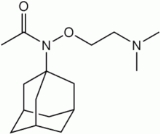
Tromantadine
Encyclopedia
Tromantadine is an antiviral medicine used to treat herpes simplex virus
. It is available in a topical gel
under trade name Viru-Merz. Its performance is similar to aciclovir
.
Like rimantadine
and amantadine
, tromantadine is a derivative of adamantane
.
replication cycle. It changes the glycoprotein
s of the host cells, therefore impeding the absorption of the virus. It inhibits penetration of the virus. It also prevents uncoating of the virions.
Herpes simplex virus
Herpes simplex virus 1 and 2 , also known as Human herpes virus 1 and 2 , are two members of the herpes virus family, Herpesviridae, that infect humans. Both HSV-1 and HSV-2 are ubiquitous and contagious...
. It is available in a topical gel
Gel
A gel is a solid, jelly-like material that can have properties ranging from soft and weak to hard and tough. Gels are defined as a substantially dilute cross-linked system, which exhibits no flow when in the steady-state...
under trade name Viru-Merz. Its performance is similar to aciclovir
Aciclovir
Aciclovir or acyclovir , chemical name acycloguanosine, abbreviated as ACV,is a guanosine analogue antiviral drug, marketed under trade names such as Cyclovir, Herpex, Acivir, Acivirax, Zovirax, and Zovir...
.
Like rimantadine
Rimantadine
Rimantadine is an orally administered antiviral drug used to treat, and in rare cases prevent, influenzavirus A infection. When taken within one to two days of developing symptoms, rimantadine can shorten the duration and moderate the severity of influenza. Both rimantadine and the similar drug...
and amantadine
Amantadine
Amantadine is the organic compound known formally as 1-adamantylamine or 1-aminoadamantane. The molecule consists of adamantane backbone that has an amino group substituted at one of the four methyne positions. This pharmaceutical is sold under the name Symmetrel for use both as an antiviral and an...
, tromantadine is a derivative of adamantane
Adamantane
Adamantane is a colorless, crystalline chemical compound with a camphor-like odor. With a formula C10H16, it is a cycloalkane and also the simplest diamondoid. Adamantane molecules consist of three cyclohexane rings arranged in the "armchair" configuration. It is unique in that it is both rigid...
.
Mechanism
Tromantadine inhibits the early and late events in the virusVirus
A virus is a small infectious agent that can replicate only inside the living cells of organisms. Viruses infect all types of organisms, from animals and plants to bacteria and archaea...
replication cycle. It changes the glycoprotein
Glycoprotein
Glycoproteins are proteins that contain oligosaccharide chains covalently attached to polypeptide side-chains. The carbohydrate is attached to the protein in a cotranslational or posttranslational modification. This process is known as glycosylation. In proteins that have segments extending...
s of the host cells, therefore impeding the absorption of the virus. It inhibits penetration of the virus. It also prevents uncoating of the virions.

